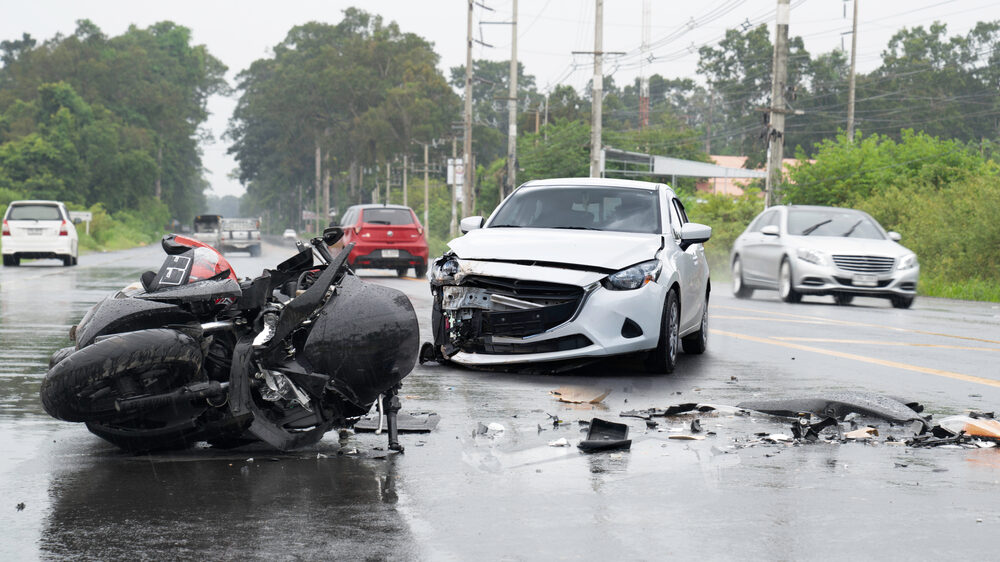Wendy’s Story
The defect in Wendy Engle’s spine probably developed in her childhood, perhaps as a result of gymnastics. Two little fractures in her bottom vertabrae, one on either side of the bony bridge that circles her spinal canal. The defect probably didn’t cause her any pain when it happened. She raised children, built a career as a nurse, and lived an active life, all without knowing about the defect in her spine. But it was there, making her vulnerable to just the right sort of trauma. The kind of trauma that happens when you get T-boned in an intersection car accident.
The Car Accident
On March 4, 2009, Wendy was driving to work on 26th Street in Erie when a driver on Greengarden Boulevard failed to stop for a red light and drove right in front of Wendy. The resulting collision was tremendous. Wendy’s Toyota Corolla was totaled and Wendy was thrown about the interior of her vehicle with enough force to crack her steering wheel and break the center console. She badly injured her low back. Doctors still don’t know exactly what happened because no one thought to look for a spinal defect until it was too late, but they believe that those two fractures were spread apart and the bone inflamed. All of Wendy’s doctors agreed, however, that the injury set off a pain syndrome that would completely change Wendy’s life. She had to change jobs, she spent three years trying every painkilling remedy known to medicine, and, finally, she agreed to have an electrical unit surgically implanted on her spinal canal to repeatedly shock her nervous system in an effort to stop the flow of pain information from her spine to her brain.
But Wendy didn’t know any of that when the accident first happened. She knew her back hurt. She thought it would get better. She thought she might miss a few days of work. And she thought that the least of her concerns were financial ones. Because, like most adult Pennsylvanians, Wendy had responsibly purchased auto insurance and, like most Pennsylvanians, Wendy thought her insurance company would live up to the promise it made to protect her in the event that she was ever injured in a car accident. Back then, Wendy couldn’t have known that her back was seriously injured and would never again be pain free — but if she’d read our website before the accident, she’d at least have had an inkling of what her insurance company was about to do to her.
At the time of the accident, Wendy was insured with State Farm. Unfortunately for her, so was the driver who ran the red light. State Farm would use both of their insureds to further State Farm’s selfish interests and jeopardize the very people State Farm had promised to protect.
Wendy’s Harms and Losses
Here, in a nutshell, was what happened: Wendy had years of physical therapy; multiple epidural injections (high-potency steroids injected directly into her spine with a three-and-a-half-inch needle); multiple facet injections (more painful injections into her spine); nerve denervation procedures (doctors burned the nerve roots exiting Wendy’s spine in an effort to stop the pain); a spinal tap; narcotic pain medications; and, finally, she underwent the spinal implant stimulator that sent electrical charges directly into her spinal canal. The surgery left three- and four-inch scars on her back and buttocks, but the stimulator helped, taking away at least some of her pain and allowing her to both get off the pain medications and increase her activity level.
Perhaps hardest of all, Wendy had to leave the job she loved and at which she’d excelled. Wendy was the head nurse at a local retirement home. She loved the residents there and the feeling was mutual. Her employer valued her highly, rapidly promoting her prior to the accident. The retirement home’s medical director said that Wendy was his good right arm, that he would never have wanted to lose her. But the job requirements were too hard on Wendy’s injured spine. Her doctors told her that she had to stop working. Her own employer suggested that she should quit and seek disability. But Wendy was no quitter. She wanted to keep working. So she found another nursing position that had fewer physical demands. Wendy was able to keep working full time despite her back injury, but her new job paid her substantially less. At her age, her total anticipated lost earnings were somewhere between $145,000 and $215,000.
The Insurance Claims
The driver who ran the red light had only $125,000 in insurance coverage. Wendy had another $100,000 in underinsured motorist coverage. Together, the combined totals were just barely enough to cover her lost wages. There wouldn’t be much left over to compensate her for her pain and suffering, for her scarring, and for all the other non-economic losses that happen with a serious injury like hers — but it would be enough, Wendy thought, to allow her to at least not suffer the full brunt of her economic losses.
So, Wendy made her claims to State Farm. She asked State Farm to pay her the $125,000 in coverage it owed to protect the driver who ran the red light. Wendy would accept that payment in return for agreeing not to pursue the driver’s personal assets. And Wendy asked State Farm to pay her the $100,000 it had promised her in underinsured motorist benefits.
State Farm’s answer? State Farm offered Wendy $12,500. State Farm told Wendy that that was all her case was worth. They told Wendy that if she thought she deserved more, then she’d have to sue them and incur the costs of litigating against one of the nation’s largest, wealthiest, and most powerful insurance companies.
Fortunately, Wendy was represented at the time by an excellent Erie injury lawyer named Anthony Sciarrino. Attorney Sciarrino knew that State Farm wasn’t being fair to Wendy and understood that he’d have to get Wendy’s case to a jury to have even a chance of getting her the compensation she deserved. So, Erie Attorney Sciarrino filed lawsuits against the driver who caused the accident and against State Farm directly, claiming that they’d breached their own insurance contract. Before the case would get to trial, Attorney Sciarrino would move to Florida and Purchase, George & Murphey, P.C. would accept responsibility for the case, ultimately trying it to a jury in February 2014.
The State Farm Contracts
State Farm had two different contracts in this case. In one, State Farm promised to protect the driver who had caused the accident. Insurance companies protect their insureds from liability by settling with the injured person. Instead of going to trial, the injured person agrees to accept a certain amount of money from the insurance company and, in exchange, the injured person releases the at-fault driver from any further responsibility. When an insurance company refuses to pay the injured person and the injured person goes to trial and gets a verdict against the at-fault driver, the at-fault driver can be personally responsible to pay any portion of the judgment that exceeds the limits of his or her insurance policy.
In its other contract, State Farm promised Wendy that it would pay her in the event that she was ever injured by a driver who didn’t have enough insurance to fully compensate her for her harms and losses. This contract required State Farm to fairly evaluate Wendy’s injuries and offer her payment without requiring her to file a lawsuit. However, if after fairly evaluating her claim, State Farm and Wendy still disagreed on the value of Wendy’s claim, then the contract required that Wendy sue State Farm and the at-fault driver and take the case to a jury trial.
By forcing Wendy to file a lawsuit, State Farm was not only refusing to honor its contract with Wendy, but State Farm was also putting the at-fault driver at risk. If the jury verdict exceeded the combined policy limits, then the at-fault driver would be personally responsible and could lose savings and other assets.
Some Inside Baseball
Now for some inside baseball. One of the dirty little secrets of Pennsylvania car accident lawsuits is that the law in Pennsylvania has developed in a way that gives insurance companies a big advantage over injured people. The law says that juries aren’t allowed to be told that an insurance company will pay the verdict. The fact that an insurance company is paying the defense lawyer and all of the expert defense witnesses is kept secret from the jury. The fact that an insurance company will pay the verdict and that the driver won’t have to personally pay the verdict is kept secret from the jury. In fact, almost any use of the word “insurance” is forbidden for fear that the jury might figure out that an insurance company is behind the scenes manipulating the trial. As a result, juries sometimes worry that the driver will be personally responsible for paying a judgment and this causes them to have sympathy for the at-fault driver. After all, we’ve all exceeded the speed limit now and again. Most people have occasionally drifted through a STOP sign or made other careless mistakes. Jurors can’t help but think how a big verdict could cost them if they were in the defendant’s shoes. Insurance companies know this and count on juries to be prejudiced by their concern for the financial harm that a big verdict would cause the defendant.
However, when an insurance company is the actual defendant (as is the case when the injured driver sues for underinsured motorist benefits), then the law is pretty clear that the jury is allowed to know about the insurance company’s involvement. This twist in circumstances in Wendy’s case was such that the jury should have known the truth about State Farm’s involvement and, thus, not have been unfairly swayed by their sympathy and concern for the at-fault driver. But, as we’ll see, State Farm had a plan that would keep the truth from the jury and still allow State Farm to maximize the cost and difficulty of the lawsuit for Wendy.
The Litigation Against State Farm and State Farm’s Highly Compensated Doctor
The lawsuits filed by Attorney Sciarrino named two defendants: the at-fault driver and State Farm. Each defendant was represented by lawyers who State Farm selected, paid, and directed throughout the case. State Farm’s multiple lawyers would each send multiple written documents like pleadings, motions, and discovery requests to Wendy, thus increasing the amount of work and expense required to build Wendy’s case.
State Farm would ultimately hire a doctor with whom State Farm was familiar, a doctor with whom State Farm had worked closely and often in the past, a doctor to whom State Farm paid $3,000 per hour to testify. The doctor was paid to examine Wendy and then testify as to his opinion. As experienced Pennsylvania injury lawyers, we had little doubt what the doctor’s opinion would be — but even we weren’t prepared for how far the doctor would go to help State Farm hurt Wendy.
When Attorney Sciarrino tried to find out more information about the relationship between State Farm and this doctor, State Farm fought vigorously to keep the details secret. State Farm’s efforts in this regard were, unfortunately, successful. But from other injury lawyers in Pennsylvania who’d tangled with this particular doctor and State Farm in the past, we were able to learn that State Farm’s doctor earned approximately $300,000 per year as an “expert witness” and, further, that his work as an expert required less than 10% of the doctor’s time.
The doctor performed as State Farm hoped. Wendy showed up for her exam in Pittsburgh, where she was one of several people being examined by the doctor that day at the request of insurance companies. The people were waiting in the reception area and lined up in exam rooms as the doctor moved from one to the next, gruffly interrogating and examining these injured people while serving his insurance company masters. Then the doctor wrote a report with the conclusions we expected. While admitting that Wendy had been injured in the accident (because the evidence was overwhelming), the doctor contended that Wendy’s back defect hadn’t been worsened by the accident. The doctor said that her back defect was going to get a lot worse regardless of whether she’d been hit by a car. He said that it was just a coincidence that it got a lot worse right after the accident.
What we hadn’t expected was what the doctor wrote about his interrogation of Wendy. He wrote that Wendy had admitted to him that she quit her job for a reason other than her injuries. He wrote that she answered questions in a way that suggested she was “symptom magnifying,” a code word for exaggerating or lying about her symptoms. These were blockbuster contentions! If true and accurate, State Farm’s doctor had discovered a perfect defense for Wendy’s lost wage claim. Not only that, but the doctor’s claims about Wendy’s symptom magnification suggested that her whole case was fabricated.
If It Hadn’t Been Recorded, No One Would Have Believed Her
Fortunately for Wendy, Attorney Sciarrino had gone with her to the examination and he’d recorded the whole thing. The recording would prove that the doctor’s claims were simply not true, complete, and/or accurate. When confronted with the fact of the recording at trial, the doctor would get angry. He would deny that he’d made anything up. He would claim that he was offended by the questions he was being asked. He would argue that an audio recording didn’t prove anything. He would claim that if Wendy didn’t have a video, then a simple audio recording was just “a waste of time.” Then he would get angry again. He would never admit that he’d lied about Wendy’s responses. He would not admit to the possibility that he’d made a mistake. The jury would ultimately decide State Farm’s doctor was not credible.
Importantly, before the trial started, State Farm knew about the recording. State Farm knew that the doctor’s claims about Wendy were false or woefully incomplete. Despite this knowledge, State Farm nevertheless used the doctor’s testimony at trial and tried to persuade the jury to rely on it to deny Wendy the compensation and insurance benefits she was owed. Even worse, they filed a motion to try to keep the jury from hearing the audiotape!
State Farm’s Clever Last-Minute Maneuver
Two days before Wendy’s trial was to begin, State Farm would orchestrate an appearance in front of the judge, ostensibly to present a motion for more time to prepare their case. The real reason, however, was to present a special proposal to the Court. State Farm’s lawyer essentially said to the Court: Judge, we don’t need to complicate this trial by being in the courtroom ourselves. If you’ll excuse us from the case, so that the jury doesn’t know that we’re involved or that we have anything to do with the case, then we’ll just agree to be bound by the outcome. That way, Judge, you’ll have fewer lawyers in the room. The trial will take less time. There will be fewer issues.
State Farm’s request was nothing short of amazing. Despite the fact that State Farm’s own policy required Wendy to sue State Farm and the at-fault driver together and to get a verdict against both; despite the fact that State Farm had actively participated in the lawsuit all throughout the case, literally increasing the difficulty and cost of the lawsuit to its insured; despite the fact that State Farm had paid for the doctor on whom their entire defense was built and then fought to keep the details of their relationship with the doctor secret…now they wanted out? State Farm’s motive was transparent. State Farm knew that they had an unfair advantage if the jury thought that the at-fault driver was the only responsible party. State Farm wanted to hide behind that driver, to keep their role secret from the jury, because they calculated that this would give them their best opportunity to hurt Wendy Engel’s chance of a fair verdict.
Unfortunately, State Farm’s gambit worked. The Court granted State Farm’s request. The jury in Wendy’s case would never know that State Farm was involved in any way.
The Verdict
Wendy’s case was tried on the first day of the February 2014 term of court in the Court of Common Pleas of Erie County, Pennsylvania. While the jury would never learn of State Farm’s involvement in the case, they learned all about the accident. They learned about the defect in Wendy’s spine that made her especially vulnerable to injury. They learned about the terrible pain that she endured and the gruesome and difficult medical procedures she agreed to undergo in an effort to reduce her pain. They learned about how Wendy’s injuries required her to give up a job that she loved and how she took another job at a substantial pay cut just so that she could keep working as a nurse.
The jury found that Wendy deserved to be compensated for the harms and losses she suffered as a result of the accident of March 4, 2009. The jury returned a verdict that compensated her for her lost earnings and for her pain and suffering, among other damages. The jury’s verdict was $375,968.32. In other words, the jury’s verdict was $363,468.32 greater than State Farm’s initial offer to Wendy. Said another way: the jury’s verdict was more than 30 times greater than State Farm’s initial offer to Wendy.
As of the date of publication of this article, State Farm has still not paid Wendy. We anticipate that there will be an appeal filed. We anticipate further that the appeal will be vigorously pursued by State Farm. We anticipate further that the appeal will fail, that State Farm will ultimately be held to account for its legal liability, and that Wendy will ultimately be compensated for her losses. Until then, we’ll keep fighting for Wendy and for all of our other clients in their battles for justice against Pennsylvania’s insurance companies.












